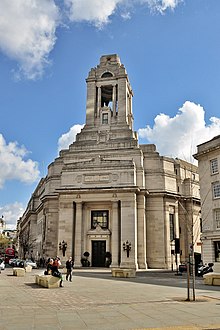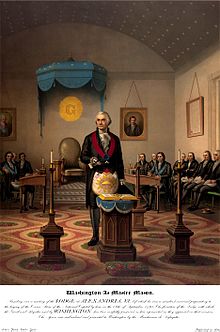Ritual and symbolism
Main article: Masonic ritual and symbolism
Freemasonry describes itself as a beautiful system of morality, veiled in allegory and illustrated by symbols.[13] The symbolism is mainly, but not exclusively, drawn from the manual tools of stonemasons - the square and compasses, the level and plumb rule, the trowel, among others. A moral lesson is attached to each of these tools, although the assignment is by no means consistent. The meaning of the symbolism is taught and explored through ritual.[10]
All Freemasons begin their journey in the "craft" by being progressively initiated, passed and raised into the three degrees of craft, or blue lodge Masonry. During these three rituals, the candidate is progressively taught the meanings of the lodge symbols, and entrusted with grips, signs and words to signify to other Masons that he has been so initiated. The initiations are part allegory and part lecture, and revolve around the construction of the Temple of Solomon, and the artistry and death of his chief architect, Hiram Abiff. The degrees are those of Entered apprentice, Fellowcraft and Master Mason. While many different versions of these rituals exist, with two different lodge layouts and versions of the Hiram myth, each version is recognisable to any Freemason from any jurisdiction.[10]
In some jurisdictions the main themes of each degree are illustrated by tracing boards. These painted depictions of Masonic themes are exhibited in the lodge according to which degree is being worked, and are explained to the candidate to illustrate the legend and symbolism of each degree.[14]
The idea of Masonic brotherhood probably descends from a 16th-century legal definition of a brother as one who has taken an oath of mutual support to another. Accordingly, Masons swear at each degree to keep the contents of that degree secret, and to support and protect their brethren unless they have broken the law.[15] In most lodges the oath or obligation is taken on a Volume of Sacred Law, whichever book of divine revelation is appropriate to the religious beliefs of the individual brother (usually the Bible in the Anglo-American tradition). In Progressive continental Freemasonry, books other than scripture are permissible, a cause of rupture between Grand lodges.[16]
Organisations of lodges
Main article: Grand Lodge
Grand Lodges and Grand Orients are independent and sovereign bodies that govern Masonry in a given country, state, or geographical area (termed a jurisdiction). There is no single overarching governing body that presides over worldwide Freemasonry; connections between different jurisdictions depend solely on mutual recognition.[17][18]
Freemasonry, as it exists in various forms all over the world, has a membership estimated by the United Grand Lodge of England at around six million worldwide.[1] The fraternity is administratively organised into independentGrand Lodges (or sometimes Grand Orients), each of which governs its own Masonic jurisdiction, which consists of subordinate (or constituent) Lodges. The largest single jurisdiction, in terms of membership, is the United Grand Lodge of England (with a membership estimated at around a quarter million). The Grand Lodge of Scotland and Grand Lodge of Ireland (taken together) have approximately 150,000 members.[1] In the United States total membership is just under two million.[19]
Recognition, amity and regularity
Relations between Grand Lodges are determined by the concept of Recognition. Each Grand Lodge maintains a list of other Grand Lodges that it recognises.[20] When two Grand Lodges recognise and are in Masonic communication with each other, they are said to be in amity, and the brethren of each may visit each other's lodges and interact Masonically. When two Grand Lodges are not in amity, inter-visitation is not allowed. There are many reasons why one Grand Lodge will withhold or withdraw recognition from another, but the two most common are Exclusive Jurisdiction and Regularity.[21]
Exclusive Jurisdiction is a concept whereby only one Grand Lodge will be recognised in any geographical area. If two Grand Lodges claim jurisdiction over the same area, the other Grand Lodges will have to choose between them, and they may not all decide to recognise the same one. (In 1849, for example, the Grand Lodge of New York split into two rival factions, each claiming to be the legitimate Grand Lodge. Other Grand Lodges had to choose between them until the schism was healed.[22]) Exclusive Jurisdiction can be waived when the two over-lapping Grand Lodges are themselves in Amity and agree to share jurisdiction (for example, since the Grand Lodge of Connecticut is in Amity with the Prince Hall Grand Lodge of Connecticut, the principle of Exclusive Jurisdiction does not apply, and other Grand Lodges may recognise both).[23]
Regularity is a concept based on adherence to Masonic Landmarks, the basic membership requirements, tenets and rituals of the craft. Each Grand Lodge sets its own definition of what these landmarks are, and thus what is Regular and what is Irregular (and the definitions do not necessarily agree between Grand Lodges). Essentially, every Grand Lodge will hold that its landmarks (its requirements, tenets and rituals) are Regular, and judge other Grand Lodges based on those. If the differences are significant, one Grand Lodge may declare the other "Irregular" and withdraw or withhold recognition.[24][25]
The most commonly shared rules for Recognition (based on Regularity) are those given by the United Grand Lodge of England in 1929:
- The Grand Lodge should be established by an existing regular Grand Lodge, or by at least three regular lodges.
- A belief in a supreme being and scripture is a condition of membership.
- Initiates should take their vows on that scripture.
- Only men can be admitted, and no relationship exists with mixed lodges.
- The Grand Lodge has complete control over the first three degrees, and is not subject to another body.
- All lodges shall display a volume of scripture with the square and compasses while in session.
- There is no discussion of politics or religion.
- "Antient landmarks, customs and usages" observed.[26]
Other degrees, orders and bodies
Main article: Masonic appendant bodies
Blue lodge Freemasonry offers only three traditional degrees, and in most jurisdictions, the rank of past or installed master. Master Masons are also able to extend their Masonic experience by taking further degrees, in appendant bodies approved by their own Grand Lodge.[27]
The Ancient and Accepted Scottish Rite is a system of 33 degrees (including the three blue lodge degrees) administered by a local or national Supreme Council. This system is popular in North America and in Continental Europe. The York Rite, with a similar range, administers three orders of Masonry, namely the Royal Arch, Cryptic Masonry and Knights Templar.[28]
In Britain, separate bodies administer each order. Freemasons are encouraged to join the Holy Royal Arch, which is linked to Mark Masonry in Scotland and Ireland, but separate in England. Templar and Cryptic Masonry also exist.[29]
In the Nordic countries the Swedish Rite is dominant; a variation of it is also used in parts of Germany.
Joining a lodge
Candidates for Freemasonry will have met most active members of the lodge they are joining before they are initiated. The process varies between jurisdictions, but the candidate will typically have been introduced by a friend at a lodge social function, or at some form of open evening in the lodge. In modern times, interested people often track down a local lodge through the Internet. The onus is on candidates to ask to join; while candidates may be encouraged to ask, they are never invited. Once the initial inquiry is made, an interview usually follows to determine the candidate's suitability. If the candidate decides to proceed from here, the lodge is balloted before he can be accepted.[30]
The absolute minimum requirement of any body of Freemasons is that the candidate must be free, and considered to be of good character.[31] There is usually an age requirement, varying greatly between Grand Lodges, and (in some jurisdictions) capable of being overridden by a dispensation from the Grand Lodge. The underlying assumption is that the candidate should be a mature adult.[30]
In addition, most Grand Lodges require the candidate to declare a belief in a Supreme Being. In a few cases, the candidate may be required to be of a specific religion. The form of Freemasonry most common in Scandinavia (known as the Swedish Rite), for example, accepts only Christians.[32] At the other end of the spectrum, "Liberal" or Continental Freemasonry, exemplified by the Grand Orient de France, does not require a declaration of belief in any deity, and accepts atheists (a cause of discord with the rest of Freemasonry).[33][34]
During the ceremony of initiation, the candidate is expected to swear (usually on a volume of sacred text appropriate to his personal religious faith) to fulfil certain obligations as a Mason. In the course of three degrees, new masons will promise to keep the secrets of their degree from lower degrees and outsiders, and to support a fellow Mason in distress (as far as practicality and the law permit).[10] There is instruction as to the duties of a Freemason, but on the whole, Freemasons are left to explore the craft in the manner they find most satisfying. Some will further explore the ritual and symbolism of the craft, others will focus their involvement on the social side of the lodge, while still others will concentrate on the charitable functions of the lodge.[35][36]



No comments:
Post a Comment